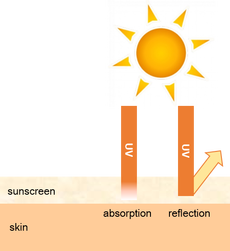How do sunscreens work?
|
Sunscreens either absorb or reflect UV radiation.
Sunscreens do this via ingredients called 'UV filters'. There are two main categories of UV filters:
|
What types of sunscreen are available?
There are many different types of sunscreen. These include:
- A range of sun protection factors (SPFs)
- Broad spectrum
- Water resistant
- Different formats such as lotions, gels, roll-ons and sprays
- Specific products designed for specific usages e.g. sport, outdoor work, or people e.g. children, sensitive skin
- Cosmetic products such as foundations, skin creams and lip products which also provide sun protection
- Sunscreens which also contain insect repellent
What does broad spectrum mean?
The sun produces two types of UV radiation that can damage the skin: UVA and UVB. Broad-spectrum sunscreens provide protection from both types of radiation. Products that are not broad spectrum protect mainly against UVB.
UVA is mainly responsible for unseen damage to the skin, resulting in premature ageing, while UVB is mainly responsible for visible damage to the skin, seen as reddening and sunburn. Both can cause skin cancer.
Broad spectrum performance is determined by an internationally recognised test procedure.[ii]
In Australia, broad spectrum is a compulsory requirement for all products that make an SPF claim except for colour cosmetic and lip products with SPF less than 30.
Broad spectrum performance is determined by an internationally recognised test procedure.[ii]
In Australia, broad spectrum is a compulsory requirement for all products that make an SPF claim except for colour cosmetic and lip products with SPF less than 30.
What does SPF mean?
SPF stands for Sun Protection Factor. It is determined by an internationally recognised test procedure.[i]
|
SPF provides a way of comparing the protection offered by different sunscreens. It indicates how much longer it will take your skin to start burning than if you were not wearing the sunscreen. This means that the SPF refers predominantly to its performance against UVB (“burning rays”).
This of course depends on you using the sunscreen correctly. |
For example, if your skin normally starts to turn red after 10 minutes in the sun, an SPF 30 sunscreen will provide sun protection for roughly 30 times as long – 300 minutes. |
In Australia, SPF claims are limited to 4, 6, 8, 10 (‘low’); 15, 20, 25 (‘medium’ or ‘moderate’); 30, 40, 50 (‘high’) and 50+ (very high’) – depending on the SPF test result. A sunscreen can only claim SPF 50+ if the average SPF test result is 60 or higher.
BUT, because there are many variables affecting how long it will take for you to burn on a particular day, SPF should not be used as an absolute guarantee of protection for a certain amount of time.
BUT, because there are many variables affecting how long it will take for you to burn on a particular day, SPF should not be used as an absolute guarantee of protection for a certain amount of time.
What does water resistant mean?
Water resistance is determined according to the test procedure described in the Australia/New Zealand Sunscreen Standard.[iii]
This requires the SPF of a sunscreen to be measured after the product is applied to skin and immersed in water for a period. For example, a product claiming 2 hours water resistance must have an SPF of between 15 and 30 after 2 hours.
The maximum water resistant claim that can be made is 4 hours. This is allowed only for products with SPF 30 or above following testing.
Sunscreens cannot claim to be ‘waterproof’.
The maximum water resistant claim that can be made is 4 hours. This is allowed only for products with SPF 30 or above following testing.
Sunscreens cannot claim to be ‘waterproof’.
References
[i] SPF is determined according to ISO 24444:2010 – Cosmetics -Sun protection test methods -In vivo determination of the sun protection factor (SPF)
[ii] Broad Spectrum is determined according to ISO 24443:2012 – Determination of sunscreen UVA photoprotection in vitro
[iii] Australian/New Zealand Standard, Sunscreen products – Evaluation and classification (AS/NZS 2604:2012), 6th Ed 2012, Standards Australia Ltd/Standards New Zealand
[i] SPF is determined according to ISO 24444:2010 – Cosmetics -Sun protection test methods -In vivo determination of the sun protection factor (SPF)
[ii] Broad Spectrum is determined according to ISO 24443:2012 – Determination of sunscreen UVA photoprotection in vitro
[iii] Australian/New Zealand Standard, Sunscreen products – Evaluation and classification (AS/NZS 2604:2012), 6th Ed 2012, Standards Australia Ltd/Standards New Zealand









